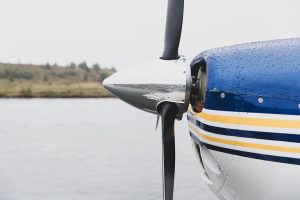Canoeing and Canada go together like few other things can. After all, 8500 rivers and 3 million lakes can be found in Canada’s wilderness. Native Americans created boats to navigate the terrain and then taught European settlers how to use them so that they could trade and colonize new areas of the country. The canoe is still popular today, but is used more for leisure than for travel. Some Canadian canoe trips are well beloved among both domestic and foreign canoeists.
Best canoe trips in Ontario
Missinaibi River
Less than 100 kilometers separate the Missinaibi river’s summit from Lake Superior’s shoreline. From here, the river rushes northeast toward James Bay, cutting the province in half as it floods to tidewater. It cuts over the rapidly eroding Canadian Shield before plunging sharply into Thunderhouse Canyon and entering the James Bay Lowlands. This river is a defining feature of Ontario’s topography.
The Polar Bear Express will pick you up at the historic Moose Factory Hudson’s Bay Company trading post and the adjoining train station to take you back down south quickly. Access points enable travel from Peterbell, Highway 11, or Missinaibi Lake Provincial Park.
For Missinaibi Lake, backcountry camping permits are needed, and backcountry registration entitles you to a first-come, first-served interior camping permit for Missinaibi River. The upper river features rocky campsites, pool-and-drop rapids, and typical shield landscape. The river widens yet continues to flow swiftly through the lowlands after Thunderhouse Falls.
Explore remote Canadian landscapes by canoe
Algonquin Park
The most iconic place to go canoeing in Canada is Algonquin Park. There are countless canoe journeys that may be taken on the more than 2,000 kilometers of canoe routes. The park is well recognized for its tranquil lakes, well-kept campgrounds, and occasional sightings of moose.
The Petawawa River is the one exception to the general trend of Algonquin being a flatwater canoeing destination. The river starts from Ralph Bice Lake in the northern part of Algonquin and runs to Lake McManus near its eastern border. Swifts, Class I and Class II rapids, and the occasional chute punctuate the river. For intermediate and seasoned whitewater paddlers, it’s an exhilarating river trip.
Allanwater River
There are several reasons why a canoeist might choose Wabakimi Provincial Park and innovative access is one of them. The southern part of the park is crossed by the nationwide passenger train service provided by Via Rail. You can board the train with your canoe ($ 100 additional fee), and then disembark at Allanwater Bridge. Although it is the busiest railroad station in Wabakimi Provincial Park, you shouldn’t anticipate any obstructions when you paddle north in your canoe after easing it into the Allanwater River.
As you travel through Brennan, Granite, Wabakimi, and Whitewater lakes to the north, there are plenty of class I and class II rapids. On Kenoji Lake, keep an eye out for pictographs, and don’t worry too much about campgrounds. The area is full of top-notch locations waiting for you to make them your home for the night. All of the portages are less than a kilometer long, and the rapids you’ll come across provide a suitable introduction for beginners. Plan on paddling the 160 km north in nine or ten days. Upon arriving at your destination, a float plane will fly you back to Armstrong’s train station.
Best canoe trips in Quebec
Dumoine River
Whitewater canoeists have been enthralled by the Upper Ottawa Valley’s Dumoine River for many years. One of the Three Sisters, together with the Noire and Coulonge rivers, empties into the Ottawa River in the south. If you start from Lac Dumoine, it will probably take you 8–10 days to paddle the entire 120 km of river. Alternatively, you could start at Benoit, from where your distance would cut down to 72 km and your paddling time to 4–6 days.
Numerous rapids spread out throughout the river, ranging from slow-moving swifts to exciting Class IIIs. The ominously dubbed Canoe Eater is a rapid that calls for skilled navigation around exposed stones. Grand Chute, a stunning set of thundering rapids and waterfalls dropping for more than a kilometer, is the location of the main portage.
Moisie River
The Moisie River, sometimes referred to as the “Nahanni of the East,” gives skilled whitewater paddlers the chance to take on challenging, high-volume rapids in a stunning, isolated setting. Two to three weeks are needed to paddle the Moisie River. Numerous Class III rapids may be found along the 440 km stretch of water, in addition to a few waterfalls and valleys that need portaging.
Before reaching Lac Felix from Lac DeMille, you must first kayak through 100 kms of lakes. The next section features multiple waterfalls that must be avoided by making several protracted portages. Another section of waterfalls and canyons, demanding portaging and difficult paddling, follows the Pékans/Moissie Confluence.
From here until Sept-Îles, the river begins to calm down a little bit. However, there are still lots of Class I-III rapids to portage or paddle through. The Moisie River is one of Canada’s most thrilling canoe courses. However, it does call for a high level of whitewater expertise. The only ways to access the river are by seaplane or helicopter.
Best canoe trips in the Maritimes
Kejimkujik National Park
Although the Maritimes are better known for sea kayaking and camping, there are a few locations that make for fantastic river canoe trips. Kejimkujik, a national park in the middle of Nova Scotia, is one such location.
Routes for Kejimkujik Canoes:
- Mersey River: This route takes the Mersey River south from Keji Lake to Low Landing. The takeout for Lake Rossignol, the biggest lake canoe circuit in the region and a short distance from the park, is located at Low Landing.
- Big Dam Lake: Starting from an entry point on Big Dam Lake, this route leads to Keji Lake via Frozen Ocean Lake. It then proceeds down a skinny river to Frozen Ocean Lake. After a few portages, you’ll reach Keji Lake, where you can cross it to go to the takeout at Jake’s Landing.
Other thrilling canoe trips in Canada
Routes in Western Canada
Along the border of Manitoba and Ontario, there are many provincial parks and parts of crown land that are great for canoe camping. The area is dotted with hundreds and possibly thousands of lakes. Its classic boreal forest landscape includes granite Canadian Shield, inky water, and pine trees. The canoe routes along the Manitoba-Ontario border are beautiful:
- Whiteshell Provincial Park: This is a short distance east of Winnipeg and is located close to Highway 17. There are a number of exhilarating canoe trips in the area, particularly if you cross over into Ontario. Big Whiteshell Lake is a typical starting point for canoe trips. In order to return to Crowduck Lake, you can paddle to Eaglenest Lake, Saddle Lake, Echo Lake, and Crowduck Lake.
- Seal River: Northern Manitoba’s Seal River is a designated Canadian Heritage River. It starts at Shethanei Lake and moves 260 kilometers north of Churchill to Hudson Bay. Seal River offers a different type of scenery because it travels through an area where boreal woodland and subarctic tundra meet.
Routes in the Territories
The Northwest Territories, Yukon, and Nunavut offer some of Canada’s best canoe excursions. Arctic canoeing is neither cheap nor simple, but the breathtaking scenery and wildlife sightings make the effort well worthwhile. If kayaking in the territories, beginners and intermediate paddlers are advised to join a guided tour due to the region’s remoteness. Paddlers with experience can go on self-guided outings, but they should be trained in wilderness first aid and rescue.
Here are canoe routes in the territories:
- The Yukon: While the most of the rivers on our list are whitewater rivers, you might want to take into account the Yukon River if you prefer a calmer pace. The Yukon River originates in northern British Columbia and travels through Alaska and Yukon before draining into the Bering Sea. You won’t be paddling the entire 3,100 km unless you have two to three months to spare. A common two-week excursion involves paddling 730 miles between Lac Laberge and Dawson City.
- Coppermine River: The beginning of the Coppermine River is not far from the Northwest Territories-Nunavut boundary. At the village of Kugluktuk, it empties into the Arctic Ocean after flowing north for more than 800 kilometers. The river is renowned for its brilliant blue water as well as its towering canyons and mountains. Muskox, caribou, grizzly bears, moose, and bald eagle sightings are frequent.
Book a canoe trip in Canada
Air Tunilik specializes in seaplane transportation services and collaborates with organizations such as ABV Kayak to plan canoe trips. Through such collaborations, we facilitate group canoe trips in remote locations or unknown areas of Quebec. Our mission is to introduce you to Canada’s most isolated areas, such as Nunavik or the North Shore of Quebec, so that you can explore the diverse flora and fauna of our stunning country.






